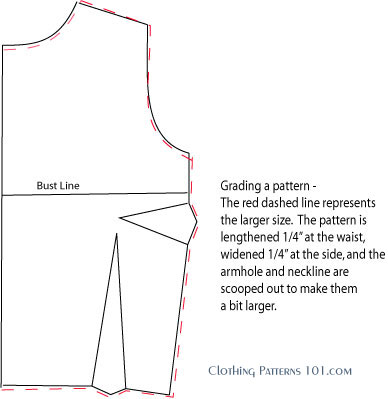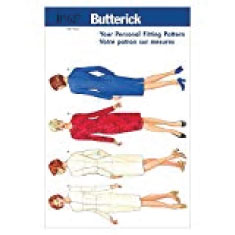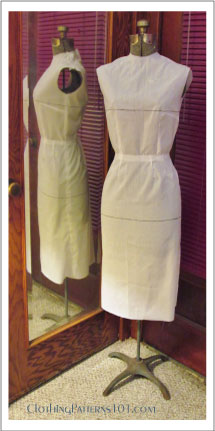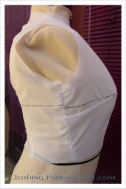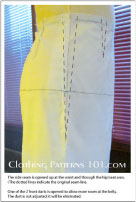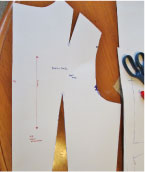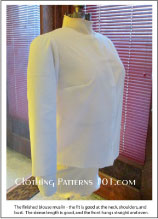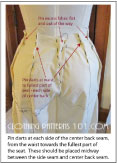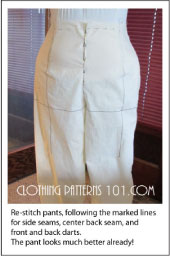- Clothing Patterns 101
- Making Clothes that Fit
- Pattern Grading
Pattern Grading to Create a Full Size Range
Pattern grading is the process of creating a range of sizes for a single style.
This isn't something that most people will need to do; but if you're a dressmaker and do bridal wear (for example) and need the same bridesmaid's dress for several people, or want to design a small line of clothing, you should understand what grading is about.
Grading a pattern and altering a pattern are two very different things.
When you grade a pattern, you are creating the same style in another size - EVERY measurement point is changed, following a strict formula, to maintain the same fit and proportion in each new size.
When you alter a pattern, you change only some parts of the pattern. For example, if your bust is a size 8, your waist is closer to a 10, and your hips are a 12. You may start with a size 10 pattern and make adjustments at the bust and hips to fit a specific body and proportion. You are not maintaining the same fit and proportion; you are creating a new one for a specific person.
Each is an important skill to learn, but remember the differences - grading is used to create a full size range for the manufacture of clothing. Altering is used for custom work, to fit a specific body.

Women's sewing patterns are generally designed to fit a specific size (usually an 8 or 10). That is the sample size, and the fit is perfected on that sample.
Once the fit is approved for that size, the pattern is "graded" for a full range of sizes (usually size 4 to 18, for misses sizes).
The "grade rules" refer to the amount of change between sizes, for each measurement point. For example, the bust, waist and hip "grade" 1" between sizes for most of the Misses size range.
If you started with a size 8 dress and needed to make another one in a size 10, you'd make the bust, waist and hip 1" larger. You'd do this primarily by making the adjustment at the side seam, and distribute the 1" size difference evenly at each seam.
Since your dress has a front and back, you'd adjust 1/2" each in the front and back. And since the front and back each have a left and right side, you'd divide that 1/2" in half again - so you'd adjust each seam (each side of the front and each side of the back) by 1/4" - the total will be a 1" difference between the sizes. Generally, you do NOT make adjustments at the center front or center back.
The shoulder, armhole, and neck would be made a bit larger also (see the sketch below to get an idea of the difference between a size and and a size 10 bodice).
Similar adjustments are made to the sleeve and skirt, as well as any other styling details (the collar would have to be adjusted to fit the neckline, for example).
The chart below shows a few of the grade rules for a Misses size range. The "+/-" means, for example, if you are starting with a size 8 and are grading to a size 10, you would ADD 1" to that area of the pattern. If you are grading down to a size 6, you would SUBTRACT 1".
You'll notice that the grade rules change as you get into sizes 12 - 16, and again for size 18.
Pattern grading is fairly complex. It's best to avoid it unless it's necessary. Even if you are making a group of garments in a variety of sizes, unless the group of people wearing them are of very similar proportions, it may be easier to fit and pattern each one separately.
However, it's worth learning if you are planning on designing and creating your own clothing line to sell.
For more information, take a look at this book from Amazon, or take the course from Craftsy.
- Essentials of Pattern Grading - While I have not personally used this book for grading, I have been told that it is actually one of the easiest to understand. And I've never found a grading book that was easy to understand!
- Create Any Size: Grading for Sewers - This class shows you the most common method of grading a pattern to another size. If the proportion is correct but the size is wrong (for example, if you are a good size 12 but the pattern is for a size 8), this course will help. And, of course, if you actually have a need to grade a full range of sizes, using this class in conjunction with the book, above, will prepare you for production!
Need More Help with Fitting Issues?
The examples on this site reflect MY fitting issues and how I resolved them. Your body is likely very different.
But, since this is a site about the mechanics of making patterns and not specifically about fitting, I'm not going to address other fit issues here. And believe me, there are others who can address this issue better than me.
Any of the books listed below will help you achieve good fit. You can use the techniques on any pattern; but why make the same corrections over an over again? Apply the principles to your block, and the fit corrections YOU need will be automatically built in to every pattern you make!
I can recommend any of the following books and an online courses to help you achieve good fit, no matter what your size or shape. I own or have used almost all of the books on this list, and have been pleased with how they address fit problems.
And there are a couple that address plus sizes, too!
Click on the links below to go to the item in Amazon. As an Amazon Associate I earn from qualifying purchases. This helps to keep this site free for your use. You are free to search Amazon for these or other similar items without using the affiliate links on this page.
I am also an affiliate of Craftsy, and receive a small commission on their classes. I have taken several Craftsy classes, and highly recommend them. Click on the text links, below, to find the classes at the Craftsy site. You may need to become a member to access the classes.
- Pattern Fitting With Confidence - A very useful book written by the late Nancy Zieman, host of the TV series "Sewing with Nancy". She provides a straightforward, down-to-earth approach to sewing and fitting. Very user-friendly.
- The Complete Photo Guide to Perfect Fitting - I love this book!!! So wonderfully illustrated with photos, using commercial patterns to demonstrate the pattern alterations. It addresses almost any fit problem you might have. So easy to understand and follow!
-Sewing for Plus Sizes - Creating Clothes that Fit and Flatter - A great book for Plus sizes! As a woman gets larger, it's not just the measurements that change - our overall proportions shift, too. This book addresses the different body types and proportions you commonly see in larger women. Truly helpful for larger women.
- Fitting Solo from Measurements to Muslin - This class shows you how to take your own measuements (fundamental to creating your block), and then make adjustments to the pattern (make these changes to the FITTING pattern for a perfectly fitted block!). You will also make a muslin, as I have described in the block-making process. It's kind of like the instructions on this site, but with video demonstrations!- Pattern Alterations: Fixing Fit Issues - This course covers pattern alterations to correct a gaping neckline, sleeve issues (including fitting the bicep), and making adjustments to the abdomen and seat areas.
- Plus Size Pattern Fitting and Design - As a size 16 (and only 5'2" tall), I qualify as a Plus size. And I've taken this class with Barbara Deckert - it is FABULOUS! Aside from the fitting tips, she also explains the style lines and silhouettes that are flattering to the Plus size figure. I highly recommend this class!
Step-by-Step: Making and Fitting Your Block
Return to Clothing Patterns 101 Home Page
ClothingPatterns101.com does not sell the personal information of its users to anyone, ever.
